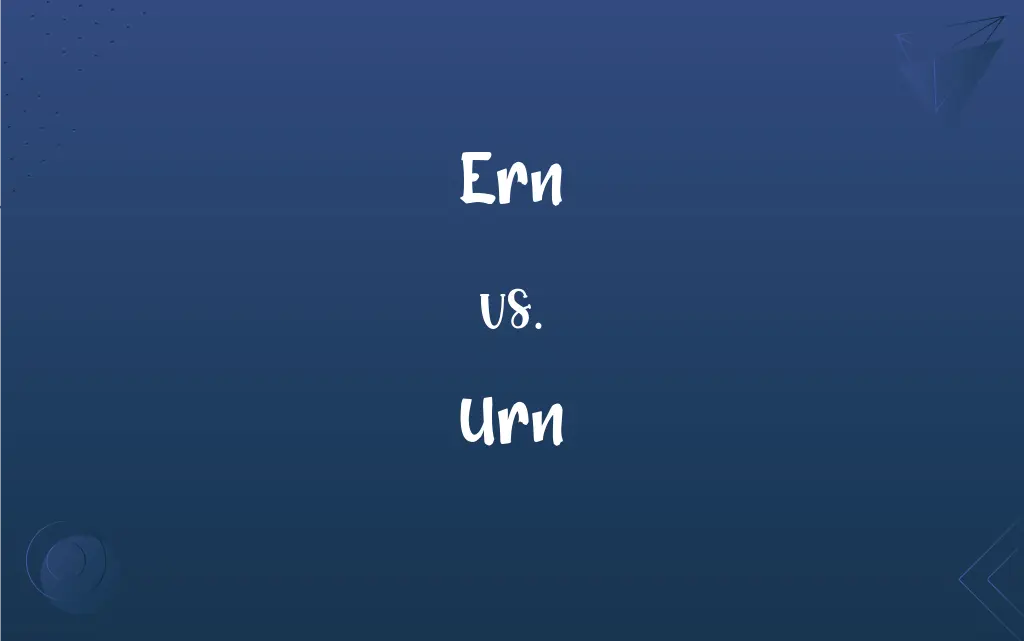Ern vs. Urn: What's the Difference?
Edited by Aimie Carlson || By Janet White || Updated on July 8, 2024
"Ern" typically refers to a sea eagle, while "urn" is a vase, often used for storing ashes of the deceased. Both words differ in meaning and usage.

Key Differences
The term "ern" primarily refers to a bird, specifically a sea eagle. It is a less commonly used variant of the word "erne," denoting a type of large bird of prey noted for its strength and ability to live near bodies of water. On the other hand, an "urn" is a type of container or vase, often crafted with a narrow neck and a wider body, traditionally used for storing the ashes of cremated individuals or as a decorative item. This distinction highlights the differences in application and context between "ern" and "urn."
"Ern" conveys a sense of the natural world, specifically referring to wildlife and the environment in which these birds thrive. It evokes images of rugged coastlines and the bird's impressive wingspan. Contrastingly, "urn" evokes a sense of human culture and tradition, being integral to various rites and ceremonies. It is associated with the preservation of memories and honoring the deceased, showcasing a profound difference in emotional resonance between the two words.
In terms of phonetics, "ern" and "urn" share similar sounds but belong to entirely different lexical categories. "Ern" is a noun that identifies a specific type of bird, contributing to the biological and ecological lexicon. "Urn," also a noun, is entrenched in both everyday and ceremonial language, illustrating its versatility in use from households to funerals. This phonetic similarity does not translate to shared contexts or meanings.
The spelling of "ern" with an 'e' as its initial vowel sets it apart from "urn," which begins with a 'u.' This difference in spelling is significant despite the words' phonetic resemblance, as it reflects their distinct origins and usage in the English language. "Ern" traces back to Old Norse, reflecting its historical context, whereas "urn" has Latin origins, hinting at its longstanding cultural significance.
The imagery associated with "ern" and "urn" diverges sharply. The former conjures up vivid pictures of wildlife and the natural habitats of sea eagles, emblematic of freedom and the wild. In contrast, "urn" brings to mind images of solemnity, remembrance, and the human desire to maintain connections with the past. This contrast underscores the unique evocative power and symbolism inherent in each word.
ADVERTISEMENT
Comparison Chart
Meaning
Refers to a sea eagle
A container for ashes or as a decorative piece
Usage in Language
Used in ornithology and nature discussions
Used in cultural, funereal, and decorative contexts
Phonetic Similarity
Sounds similar to "urn" but has distinct usage
Sounds similar to "ern" but differs in meaning and context
Spelling
Begins with "e," hinting at its natural world linkage
Begins with "u," suggesting its human cultural connection
Imagery and Symbolism
Evokes natural landscapes and freedom
Symbolizes memory, tradition, and ceremony
ADVERTISEMENT
Ern and Urn Definitions
Ern
A sea eagle.
The ern soared above the coastal cliffs, scanning the waves.
Urn
Symbolically, represents mortality or the passage of time.
The urn in the poem stood as a stark symbol of mortality.
Ern
In symbolic or metaphorical language, representing freedom or majesty.
He stood tall and solitary, an ern against the stormy sky.
Urn
A vase with a lid used for storing cremated ashes.
The family placed the urn on the mantlepiece, a somber reminder of their loss.
Ern
Alternative spelling for ern, emphasizing dialect or historical usage.
In ancient texts, the ern is often mentioned alongside other birds of prey.
Urn
A container used in ancient ceremonies or rituals.
The museum displayed an ancient urn, intricately decorated and used in rites.
Ern
Used in poetry or literature for a concise rhythm or rhyme.
The ern's cry pierces the misty morn.
Urn
In decorative arts, a motif or form emulating historic urns.
The garden was adorned with urns filled with vibrant flowers.
Ern
In regional dialects, a specific reference to the local wildlife.
On our hikes, we often spot an ern circling above.
Urn
In a modern context, a large vessel for coffee or tea at gatherings.
We set up an urn of coffee for the early morning meeting attendees.
Ern
A sea eagle, especially Haliaeetus albicilla of Europe.
Urn
A vase of varying size and shape, usually having a footed base or pedestal, especially a lidded vase used to hold the ashes of one who has been cremated.
FAQs
How do you spell ern?
Ern is spelled E-R-N.
What is an ern?
An ern is a sea eagle, known for its large size and habitat near water.
What is an urn?
An urn is a container, often used for storing the ashes of the deceased or as a decorative item.
Are ern and urn interchangeable?
No, they refer to completely different things—one a bird, the other a container.
Can ern be used in poetry?
Yes, ern can be used in poetry for its symbolic meanings or phonetic fit.
How do you spell urn?
Urn is spelled U-R-N.
Can urn be used in a modern context outside of funerals?
Yes, urns can also refer to large beverage containers or decorative elements.
Is there a specific habitat associated with erns?
Erns are typically found near coastal areas or large bodies of water.
Do urns have a historical significance?
Yes, urns have been used historically in funerary practices and are significant in archaeology.
What does an ern symbolize?
An ern often symbolizes strength, freedom, and the natural world.
Are urns found in specific cultures?
Urns have been used across various cultures for centuries in both ceremonial and decorative capacities.
Do erns have a significant role in any folklore or mythology?
In some cultures, the ern, or sea eagle, is a symbol of power and majesty in folklore.
What does an urn symbolize?
An urn can symbolize memory, mourning, and the passage of time.
What materials are erns made of?
This question is misphrased as erns are birds, not made materials.
How do you care for an urn?
Care depends on the material, but generally involves gentle cleaning and avoiding harsh chemicals.
What materials can urns be made from?
Urns can be made from metal, ceramic, wood, or even biodegradable materials.
Can erns be seen in captivity?
Yes, erns can be found in some wildlife reserves and zoos.
Are there different types of erns?
"Ern" specifically refers to the sea eagle, but there are various species within the eagle family.
Are there different styles of urns?
Yes, urns come in various styles and designs, reflecting different cultures and purposes.
How are urns used in modern funeral practices?
Urns are used to hold the ashes of cremated individuals, often during memorial services or kept as keepsakes.
About Author
Written by
Janet WhiteJanet White has been an esteemed writer and blogger for Difference Wiki. Holding a Master's degree in Science and Medical Journalism from the prestigious Boston University, she has consistently demonstrated her expertise and passion for her field. When she's not immersed in her work, Janet relishes her time exercising, delving into a good book, and cherishing moments with friends and family.
Edited by
Aimie CarlsonAimie Carlson, holding a master's degree in English literature, is a fervent English language enthusiast. She lends her writing talents to Difference Wiki, a prominent website that specializes in comparisons, offering readers insightful analyses that both captivate and inform.































































